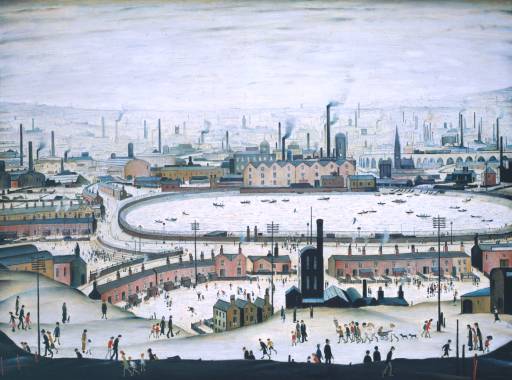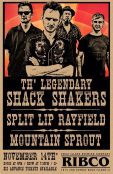Shooting the White Elephant
Like an understanding that only those of us affected would realise (viz., the changing tide and motion, moving beyond motive and motivation, holding kindness and tranquillity) Lowry places these in the faces of rough justice under the weight of depression in his paintings.
So as I sit in the front gallery, listening to the sounds of freshly ground coffee and the clip of high heeled shoes, the shuffle of feet, and the odd natter of dispersed peoples, I begin to wonder.
The mind drifts to flagrant observations of telephone calls between people some twenty metres away from each other and back to mobilised wheelchairs. I cannot yet think that I am an ungainly white elephant sitting in a room writing as I recall my entrance to the gallery.
Fantastic moustaches, The Cripples and bowler hats
“Fantastic moustache”, conversed a lady that had spied my facial hair whilst I was taking photos prior to going in for my second visit. “Why thank you” I replied, it could be said this is an ultimate compliment as you walk into a Lowry exhibition that is flooded with bowler hats, fantastic moustaches, cravats and the like.
She was a grey-haired lady with a man in a wheelchair that she had flown over to see, and whom she flys backwards and forth to meet. From our conversation, I gather that she’s from the mid-West, Missouri in fact, and found love online with the man she’s with. One can only create in mind the back stories and histories of characters that you meet, but I cannot help but think that she was touched by the depressing nature of the exhibition.
Looking rather bereaved as I asked her about the exhibition; it made her feel sad and reflective of the pain in her own past, and like Lowry, you could see it in her eyes. Eyes that remind me of my grandmothers; of the pain and suffering of a generation that had fought their position in great distress, an ashen blue iris that swims with steel grey.
pain and suffering in the blood that seems to weep from Lowry’s eyes
We see this pain and suffering in the blood that seems to weep from Lowry’s eyes in his self-portraits, magnifying the context in which the landscapes of people sit. That sadness and pain that Lowry reveals in himself, and reveals in us, is why you see scars of grief and honesty in people exiting his exhibition, which only the best protagonist can evoke.
We continued to talk about the exhibition and whether there was a political edginess to Lowry’s subjects; The Cripples (1949) for instance, projects a backdrop of gated inner city communities, factories and a church to boot. “Does this not symbolise a time of division of wealth and prosperity that has pushed its ‘cripples’ to the outer edge, holding dear the closeness of its own communities whilst creating new ones outside the gates?”.
“I suppose it does, although I wasn’t looking at them in that way”. I see a drop in her eyes and a flicker of excitement of progress made by modern society as she glances at the man she is seeing. We continue to talk art and life for a bit, then part ways with a friendly handshake.
‘Modern Society’
I am now thinking of the historical significance of Lowry’s work, an imprint of ‘modern society’ in the early thirties that is going through a depression of economic growth, and ask myself what Lowry would paint if he were here today? To imprint a Manchester that was part of a nation with its back against the wall.
He would paint a million people running heedlessly between McDonalds, Tesco and a high street bank, consuming all that has been spelled out to them under marketing and advertising banners, as a few sit pretty in high rise city flats and offices. As the church in Lowry’s ‘modern society’ of the 1930s was to his subjects, the church of consumerism and overtly matured capitalism would be central subject to 2010’s ‘modern society’.
Maybe the pain and the suffering that you see in Lowry’s work comes from the misery of walking past cripples and street children, like I have felt when in any developing nation's city, town or village. But the pain and suffering that you would see in Lowry’s work if he was to paint today’s modern society would be the detachment of interaction found in technology. For you don’t have to see, meet or talk to poverty-stricken people in today’s modern society. A click of a button or a telephone call to a charity will solve those undeniably sore spots that we all feel when it comes to what Lowry would describe as ‘cripples’.

And it is the government of 1947 that developed and signed off a NHS bill that now looks after people from cradle to grave. A year later in 1948, The Park hospital was opened in Manchester, now the Trafford General Hospital, and a year after that The Cripples was painted. Would it be too brash to mention the current situation with the NHS reform bill? No.
Pond life, the House of God, and the Sprit of Capitalism
Getting back on topic, it is the reality that Lowry established and in which Lowry gains his historical symbolic roots. For when I saw (and spoke to) a man sitting in an armchair in the Lakeside, looking rather forlorn as he had just exited the exhibition, it gives one a realisation. A realisation in me and you that makes a person feel the memories of past, and brings a person to sit and rub his face as if the world is upon him.
, oil.jpg)
So when you stare at Lowry’s bleak towering churches with wrought iron gates you get the impression that all is not well, a medieval relic of the past that draws the masses and enslaves hope. You see this in Lowry’s drawings and paintings of churches most effectively. Not bright and beautiful churches that shine hope and prosperity, but dark and gothic ones that dampen the surroundings. But the best illustration of this would be Untitled (St. Simon’s Church [catholic]) (1927). Unfortunately the internet doesn’t hold a photo of this.
Not bright and beautiful churches that shine hope and prosperity, but dark and gothic ones that dampen the surroundings
By drawing and painting churches in this way, Lowry sees through the guise of solidified obscurity and places the hand on the other foot. Pulling it up and kicking himself in the face to wake up and smell the coal-fired furnaces that billow out of his paintings, and see through the life he led. It seems as if he has just gone through enlightenment, heeding the knowledge of Max Weber, The Protestant Ethic and the Spirit of Capitalism, and is now reviewing his own scenery in a bleak trance of deep perception.
In Looking at The Pond (1950), Lowry must have recognised that he was documenting the Manchester landscape, at such a time he may have foreseen that eventually it would be turned to rubble. The factories bodies, although painted in a lighter shade, hold above them tall chimneys that scar/divide the landscape. You cannot help think he had a love/hate relationship with them.

It is uncertain for me whether Lowry see’s these chimneys as the Stellae of Northern England, or as a source of exhaustion. Lowry did shovel coal in the war, which makes you wonder how this works into some of his work. It does seem as if the geometric layout of The Pond (ibid.) encapsulates the ringfence of class-based, wealth-orientated ‘modern’ society’s rowing boats, placing the man and his dog on the hill, and a mass of factories and congestion as its backdrop with an ever-present church.
Finishing rant
Understanding Lowry’s subject matter and style of painting is a difficulty, in many respects it hangs heavily on the mind as a reflection on society continued. People are always doing something, going here or going there, and the work places people as non-entities that all can relate to, below gigantic buildings and vast landscapes.
Personally, his portraits are his most rewarding paintings on the eye and give weight to his landscapes, which places an awkward perspective on the beauty of industrialisation. Apart from bowler hats, cravats and the odd fantastic moustache, the characters in Lowry’s paintings stem from their interaction with the environment that they are surrounded by. Which shows the importance which Lowry placed on creating terraced houses, churches, industrial buildings and the like. More importantly, it places an emphasis on what Lowry was trying to depict in his work and document his surroundings.
Bleak, dark, clean, industrial, transparent, and precise with a childlike nature comes to mind when reviewing Lowry’s work, where his honest, personal, and historically-edgy approach can be enveloped as to describe his subjects. That, in turn, draws out realities, pain, happiness, and enjoyment in his work.
All images courtesy of The Lowry

The aim of art is to represent not the outward appearance of things, but their inward significance. – Aristotle
















